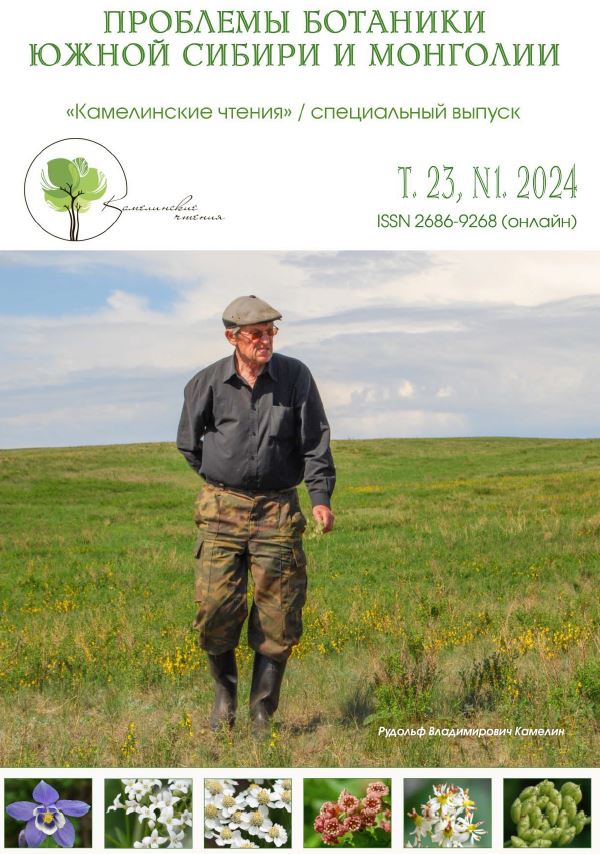About the new floristic region of the Daurian-Manchurian province in Buryatia (East Asian sub-kingdom of the Holarctic): to the characteristics of the Daurian prairies of the Dzhida Valley
УДК 581.9(571.54)
Abstract
The territory of Selenga Buryatia in the south of Eastern Siberia, adjacent to the Amur basin, according to botanical and geographical zoning, belongs to the Dauro-Manchurian province of the East Asian sub-kingdom of the Holarctic. According to the global climatic gradients from the continental Baikal region to the Pacific Ocean, the Amur basin is differentiated into three sectors - Basic, Active and Peripheral.The basic edge-continental region is located in a zone of direct oceanic influence, causing high moisture supply to vegetation, with the dominance of coniferous-deciduous forest, meadow and swamp ecosystems. The Pacific is the deepest - the Far Eastern monsoon along the Amur basin reaches deep into the continent to the Selenga Dauria. This is expressed in the uniqueness of the vegetation of the tributaries of the Selenga basin - the valleys of the Khilok, Uda, Chikoy, Temnik and Dzhida rivers. The sublatitudinal extent of the Dzhida valley made it possible for the Far East monsoon to penetrate deeper into the interior of Buryatia near Selenga, which contributed to the migration of East Asian elements and constitutes an outpost of the Daurian prairies in the Selenga basin. This phenomenon is expressed not only in the characteristics of the flora, but also in the structure of vegetation, which is characterized by special florocenotypes of vegetation along with steppes, forest and forest-steppe landscapes on watersheds.In the landscapes of the Selenga Dauria, confined to the peripheral area of influence of the Far Eastern monsoon, the refugia of the Daurian prairies have been preserved: 1. prairie with Agropyron, Lespedeza and Ulmus pumila near the confluence of the Dzhida with Selenga rivers - locality Selger; 2. Forb-grass prairie with Lilium pumilum on the Dzelter terraces (along the right bank of the valley - a tributary of the Dzhida river); 3. Forb-grass prairie with Bupleurum scorzonerifolium in the foothills along the left bank of the Altsak River valley - on gently ridged trails (near the confluence with the Armak river).In the species composition of three reference prairie communities, the predominance of the forb fraction in the botanical composition of the grass stand was revealed, in the prairie/steppe ratio, respectively: 25.3 % / 7.6%. Analysis of the diversity of geoelements (arealogical groups) in the cenoflora of communities showed the dominance of East Asian and Manchurian-Daurian species - 16 out of 18 (89% of the total composition).The characteristic species of the prairie floristic complex include Bupleurum scorzonerifolium, Scabiosa comosa, Filifolium sibiricum, Lespedeza davurica, Saposhnikovia divaricata, Lilium pumilum, Delphinium grandiflorum, Artemisia messerschmidtiana and others.
Downloads
Metrics
References
Васильев В. Н. Ботанико-географическое районирование Восточной Сибири // Ученые записки Ленингр. пед. ин-та им. Герцена, 1956. - Т. 116. - С. 61-103.
Галанин А. В., Беликович А. В. Восточноазиатская гумидная и Азиатско-Североамериканская аридная ботанико-географические дуги [Электронный ресурс] // Наша Ботаничка. - Владивосток, 2012. URL: http://ukhtoma. ru/geobotany/arc_01.htm
Дулепова Б. И. Особенности флоры и растительности Даурской лесостепи. - Чита: Изд-во ЗабГПУ им. Н. Г. Чернышевского, 2004. - 82 с.
Колесников Б. П. Очерк растительности Дальнего Востока. - Хабаровск: Хабаровское книж. изд-во, 1955. - 104 с.
Камелин Р. В. Флороценотипы Монгольской Народной Республики // Бот. журн., 1987. - Т. 72, № 12. - С. 1580-1594.
Камелин Р. В. Монголия на карте ботанико-географического районирования Палеарктики // Turczaninowia, 2010. - Т. 13, № 3. - С. 5-11.
Куминова А. В. Степи Забайкалья и их место в ботанико-географическом районировании Даурии // Тр. Биолог. Института Томского Государственного Университета им. В. В. Куйбышева, 1938. - Т. V. - С. 87-130.
Малышев Л. И., Бардунов Л. В. География притихоокеанских флористических элементов Восточной Сибири (в связи с миграциями и эволюцией флор в бассейне Тихого океана) // Доклады Института географии Сибири и Дальнего Востока, 1966. - Вып. 12. - С. 47-51.
Намзалов Б. Б. О растительности долины Дзэлтэра и ее месте в ботанико-географическом районировании (бассейн р. Селенга, Монголия). Воспоминания о совместной экспедиции с Р. В. Камелиным // Turczaninowia, 2016. - Т. 19, № 4. - С. 40-46.
Пешкова Г. А. Степная флора Байкальской Сибири. - М: Изд-во «Наука», 1972. - 207 с.
Пешкова Г. А. Даурская лесостепь (состав, особенности, генезис). - Барнаул: «ARTIKA», 2010. - 144 с.
Рещиков М. А. К вопросу об истории степной растительности Забайкалья и геоботаническом районировании // Естественные пастбища Забайкалья и приемы повышения устойчивости растений к засухе и холоду. - Улан-Удэ: Бурят. кн. изд-во, 1971. - С. 71-82.
Сочава В. Б. Закономерности географии растительного покрова горных тундр СССР // Академику В. Н. Сукачеву к 75-летию со дня рождения. - М.: Л.: Изд-во АН СССР, 1956. - С. 522-536.
Чернышева О. А., Плешанов А. С., Верхозина А. В. Ландшафтное распределение реликтовых сосудистых растений в Верхнем Приангарье // Проблема и стратегия сохранения биоразнообразия растительного мира Северной Азии: Материалы Всерос. конф. - Новосибирск: ЦСБС СО РАН, 2009. - С. 264-265.
Шатилина Т. А., Анжина Г. И. Изменчивость интенсивности дальневосточного муссона в 1948-2010 гг. // Известия ТИНРО, 2011. - Т. 167. - С. 146-159.



